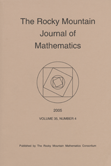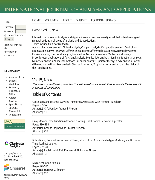
Bulletin of Mathematical Analysis and Applications
Scope & Guideline
Bridging Theory and Practice in Mathematical Analysis
Introduction
Aims and Scopes
- Mathematical Analysis:
The journal emphasizes rigorous mathematical analysis, including but not limited to fixed point theory, convergence, and stability analysis, exploring both traditional and modern techniques. - Differential Equations:
A significant portion of the journal's publications revolves around differential equations, particularly semilinear and fractional equations, showcasing their applications in various fields. - Metric Spaces and Topology:
The exploration of properties of metric spaces, including quasi-metric spaces and fuzzy normed spaces, is a core focus, reflecting the journal's interest in topology and functional analysis. - Operator Theory:
Research related to operators, including their properties and applications in functional spaces, is consistently featured, highlighting the journal's dedication to operator theory. - Statistical Convergence:
The journal publishes works on statistical convergence, particularly in the context of sequences and functions, which is a crucial aspect of modern analysis. - Applications of Mathematical Concepts:
There is a strong emphasis on applying mathematical theories to real-world problems, particularly in physics, engineering, and economics, demonstrating the journal's commitment to practical applications.
Trending and Emerging
- Nonlinear Differential Equations:
There is an increasing trend towards the study of nonlinear differential equations, particularly in the context of impulsive systems and fractional calculus, indicating a growing interest in complex dynamic systems. - Fixed Point Theory:
Recent works have shown a resurgence in fixed point theory, particularly in generalized and fuzzy settings, which suggests a renewed interest in this foundational topic. - Fuzzy and Rough Set Theory:
Emerging research on fuzzy and rough set theories highlights their applicability in various mathematical contexts, reflecting a growing trend in the study of uncertainty and imprecision. - Neutrosophic Analysis:
The exploration of neutrosophic metric spaces represents an innovative approach to analysis, indicating the journal's engagement with cutting-edge mathematical concepts. - Statistical Summability Techniques:
There is an upward trend in the use of statistical summability techniques, emphasizing their relevance in modern analysis and applications in mathematical modeling.
Declining or Waning
- Classical Function Theory:
The exploration of classical function theory and its traditional applications has decreased, possibly due to the rise of more advanced and abstract mathematical concepts. - Basic Algebraic Structures:
There has been a noticeable decline in papers focusing on elementary algebraic structures, as the journal's focus shifts towards more complex analysis and operator theory. - Discrete Mathematics:
Research related to discrete mathematics, including combinatorial aspects, appears less frequently, which may reflect a broader shift in the journal's thematic focus. - Elementary Statistical Methods:
The journal has moved away from basic statistical methods and approaches, favoring more advanced topics in statistical convergence and fuzzy analysis.
Similar Journals

HOUSTON JOURNAL OF MATHEMATICS
Cultivating Academic Dialogue in Mathematical ResearchHOUSTON JOURNAL OF MATHEMATICS, published by the University of Houston, serves as a valuable platform for disseminating significant findings in the field of mathematics, specifically within the realm of miscellaneous mathematics. Despite its current categorization in Q4 for 2023, the journal plays a crucial role in fostering academic discussion and exploration among researchers, professionals, and students alike. With its ISSN 0362-1588, the journal has been publishing original research since 1996, with a recent gap filled from 2022 to 2023, thereby continuing to contribute to the mathematical community. While it does not currently offer open access options, the journal's commitment to quality research maintains its relevance within the field and invites submissions that can elevate its standing. Located in the vibrant city of Houston, Texas, the journal not only emphasizes theoretical advancements but also encourages applied mathematical research that intersects with other disciplines, enhancing its significance and reach.

Constructive Mathematical Analysis
Bridging Ideas and Research in Constructive Mathematical AnalysisConstructive Mathematical Analysis is a distinguished open-access journal dedicated to advancing the field of mathematical analysis, specifically through constructive methods. Published by Tuncer ACAR and affiliated with Selcuk University in Turkey, this journal has been making a significant impact in the academic community since its inception in 2018. With an emerging presence in Scopus, it has earned a Q2 ranking in key categories including Analysis, Applied Mathematics, and Numerical Analysis for 2023, reflecting its commitment to high-quality research contributions. By providing a platform for innovative research and interdisciplinary approaches, "Constructive Mathematical Analysis" aims to facilitate collaboration among researchers, educators, and students in their pursuit of knowledge in mathematical science. With its open-access model, the journal ensures that research findings are accessible to a global audience, fostering an inclusive academic environment.

Acta Universitatis Sapientiae-Mathematica
Exploring innovative solutions in contemporary mathematics.Acta Universitatis Sapientiae-Mathematica is a dynamic and open-access academic journal published by SCIENDO, dedicated to advancing research in the field of mathematics. With its roots grounded in Germany, the journal has made significant strides in promoting scholarly contributions since it became open access in 2013, enhancing accessibility for researchers, professionals, and students alike. Spanning a broad spectrum of mathematical disciplines, including general mathematics, the journal engages with contemporary challenges and offers a platform to explore innovative approaches. Although currently positioned in the Q4 quartile for 2023 within the miscellaneous mathematics category and holding a Scopus rank of #290 out of 399, the journal is committed to fostering intellectual discourse and enhancing the overall quality of mathematics research. The convergence of research presented since 2014 showcases a journey toward improvement and expanding its influence in the mathematical community. Contribute to the vibrant dialogue in mathematics by exploring the latest findings in Acta Universitatis Sapientiae-Mathematica as it continues to evolve in the academic landscape.

St Petersburg Mathematical Journal
Connecting Minds through Cutting-edge Mathematical ResearchSt Petersburg Mathematical Journal, published by the American Mathematical Society, is a distinguished platform that fosters research and discourse in the fields of mathematics, specifically focusing on Algebra and Number Theory, Analysis, and Applied Mathematics. With an ISSN of 1061-0022 and an E-ISSN of 1547-7371, this journal has been a reliable source of cutting-edge mathematical research since its inception in 2003 and continues to publish high-quality content through 2024. Although not open-access, it offers valuable insights and advances the mathematical community's understanding, as indicated by its respectable impact factor and Scopus rankings across various categories—landing in the Q3 quartile across three significant mathematical disciplines. Researchers, professionals, and students are encouraged to contribute and engage with this journal, as it remains a vital resource for promoting collaboration and discovery within the ever-evolving field of mathematics.

Ukrainian Mathematical Journal
Pioneering Insights in MathematicsThe Ukrainian Mathematical Journal is a prominent academic publication in the field of mathematics, focusing on a diverse range of topics that appeal to researchers, professionals, and students alike. Published by Springer, this journal has been an important platform for disseminating significant mathematical research since its inception in 1957. With the aim of fostering knowledge and collaboration within the mathematical community, the journal curates high-quality articles that meet rigorous scholarly standards, evidenced by its Q3 ranking in the miscellaneous mathematics category for 2023. Although it currently does not offer open access, the journal remains accessible through various institutional subscriptions. It serves as a vital resource for ongoing discourse in the field and invites contributions that further advance mathematical understanding.

ROCKY MOUNTAIN JOURNAL OF MATHEMATICS
Fostering Collaboration in Diverse Mathematical FieldsROCKY MOUNTAIN JOURNAL OF MATHEMATICS, published by the Rocky Mountain Math Consortium, serves as a critical platform for researchers and practitioners in the field of mathematics since its inception in 1971. With a notable presence in the academic community, this journal covers a broad spectrum of mathematical disciplines, positioning itself in the Q2 category for Mathematics (miscellaneous) as of 2023. Despite being a subscription-based journal, it is recognized for its rigorous peer-review process and contributions to theoretical and applied mathematics, helping to advance knowledge and foster collaboration among mathematicians. The journal's ISSN number is 0035-7596 and its E-ISSN is 1945-3795, reflecting its commitment to accessibility and dissemination of high-quality research. Based in Tempe, Arizona, at Arizona State University, the journal continues to play an important role in shaping contemporary mathematical discourse through well-researched articles and innovative studies, aiming to bridge gaps between various mathematical subfields and engage a diverse audience, including students and established researchers alike.

Tamkang Journal of Mathematics
Connecting Researchers to the Heart of Mathematical DiscoveryTamkang Journal of Mathematics, published by TAMKANG UNIVERSITY, serves as a vital platform for researchers and professionals in the fields of applied mathematics, general mathematics, and materials science. With an ISSN of 0049-2930 and an E-ISSN of 2073-9826, this journal has established itself within the academic community, particularly noted for its contributions from Taiwan. Although categorized as Q4 in Applied Mathematics and Q3 in multiple related fields according to the 2023 ranking, it maintains a solid reputation for disseminating significant research findings and innovative methodologies. Researchers can explore an array of topics within its pages, making it an excellent resource for enhancing mathematical knowledge and applications. As it converges from 2005 to 2024, the journal invites academics, professionals, and students to engage with its content and contribute to the ongoing dialogue in mathematics and its interdisciplinary applications.

Facta Universitatis-Series Mathematics and Informatics
Integrating Innovation: Where Mathematics Meets InformaticsFacta Universitatis-Series Mathematics and Informatics is a prestigious interdisciplinary journal published by UNIV NIS that emphasizes the integration of mathematical theories and computational methods essential for advancements in various scientific fields. With the ISSN 0352-9665 and E-ISSN 2406-047X, this journal serves as a vital platform for researchers and professionals to disseminate cutting-edge findings related to mathematics and informatics. As an open-access journal, it aims to enhance the visibility and accessibility of high-quality research, fostering collaboration among scholars globally. The journal's commitment to excellence is evident in its rigorous peer-review process, which ensures that only the most impactful and innovative research papers are published. Set against the backdrop of its esteemed Serbian institution, Facta Universitatis not only aims to contribute to the global academic discourse but also to inspire the next generation of mathematicians and computer scientists. As the field continues to evolve, this journal plays a crucial role in shaping the future landscape of mathematics and informatics.

International Journal of Analysis and Applications
Connecting disciplines through applied mathematics and analysis.International Journal of Analysis and Applications, published by ETAMATHS PUBL, is a premier open-access journal dedicated to fostering advancements in the fields of analysis, applied mathematics, geometry, topology, and their applications in business and international management. With a commitment to providing high-quality research, the journal has been an open-access platform since 2013, ensuring that researchers, professionals, and students have unhindered access to valuable findings and methodologies. Based in Vancouver, Canada, the journal’s scope spans a diverse range of mathematical disciplines, bridging theoretical concepts with practical applications. The journal has been categorized in various quartiles as of 2023, reaching Q4 in Analysis and Applied Mathematics, and Q3 in Business and International Management, highlighting its growing importance in the academic community. At present, it is ranked 55th in Geometry and Topology and holds a respectable position within the Scopus database. By fostering innovative research and providing a collaborative platform, the International Journal of Analysis and Applications aims to contribute significantly to the development and application of mathematical theory in contemporary settings.

Journal of Analysis
Pioneering Research Across Mathematical LandscapesThe Journal of Analysis, published by SPRINGERNATURE, serves as a crucial platform for disseminating advanced research in the fields of mathematics, particularly focusing on Algebra, Number Theory, Analysis, Applied Mathematics, Geometry, Topology, and Numerical Analysis. Since its inception in 2016, this journal has aimed to foster knowledge-sharing and innovation among researchers, professionals, and students. Boasting a diverse scope and a commitment to high-quality research, the journal is indexed in various categories with rankings that reflect its growing influence, particularly in Algebra and Number Theory (Q4), Analysis (Q3), and Applied Mathematics (Q3), among others. With an ISSN of 0971-3611 and E-ISSN of 2367-2501, it offers insightful articles that contribute to the ongoing discourse in mathematics. The journal is located in Germany, ensuring a European perspective while also welcoming global contributions. Researchers seeking to enhance their understanding and impact in their respective fields will find this journal an invaluable resource.